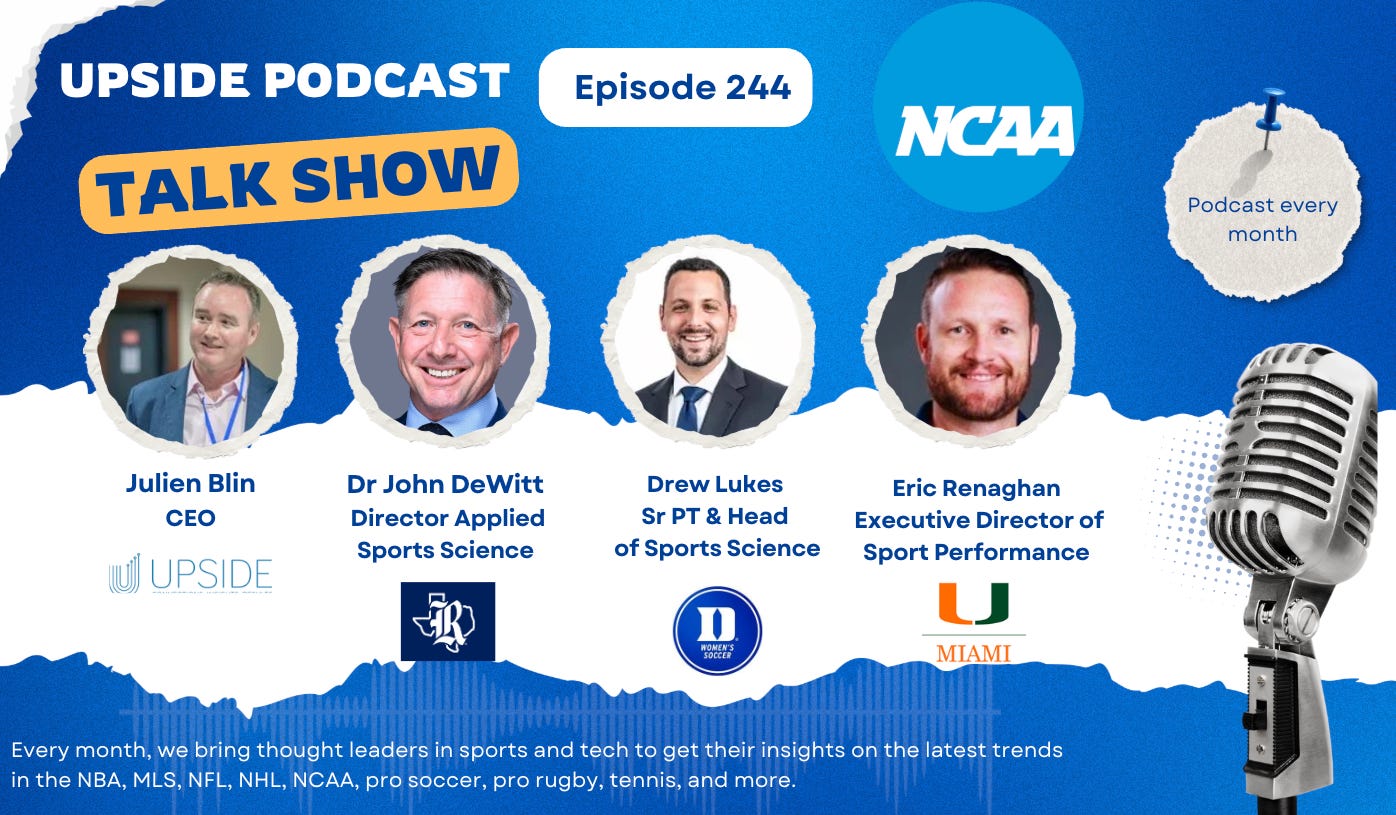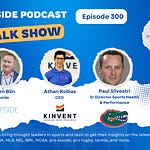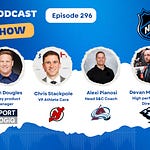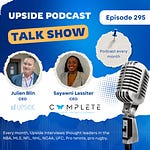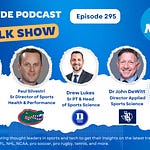This week we had the honor to interview a group of NCAA sports performance experts.
Dr. John DeWitt, director of applied sports science in the athletic department and a faculty member, Rice University (NCAA team).
Eric Renaghan, Executive Director of Sport Performance, University of Miami (NCAA team).
Drew Lukes, Senior PT at Duke University and the head of sports science, Duke university’s women soccer team (NCAA team).
You can read the full transcript of the podcast interview with Eric, Drew, and John located at the top of this blog post.
Here are some of the best quotes of our conversation with them:
Q1. How has the transfer portal reshaped team culture, leadership development, and continuity?
Eric Renaghan (University of Miami):
“The transfer portal has fundamentally changed college sports. It’s essentially turned the NCAA into a professional environment where you’re not just recruiting new talent, but you’re now also recruiting your own players to stay. That’s never really been the case before. What makes it especially tough is we don’t just have one transfer window like pro leagues. We’ve got multiple across the year. So, it’s constant—trying to build cohesion while guys are coming and going. From a physical performance standpoint, that part of our work doesn’t really change—we’re still focused on keeping everyone healthy and progressing—but now we have players coming in from different systems, different training histories, and we have to quickly assess and integrate them. It’s like mid-season trades in the pros, and that can really stress your culture if you’re not deliberate about it.”
Drew Lukes (Duke University):
“We’re in a transitional era where some athletes have been with their program for four or five years—before NIL, before the portal exploded—and they’re now seeing newcomers arrive with massive NIL deals. That dynamic creates tension. You might have a senior who’s contributed for years sitting next to a freshman transfer making more in NIL than they’ve ever seen. That forces some difficult conversations. From a support staff perspective, we’re having to adapt by accelerating onboarding. So, it’s all about tightening your processes while staying aligned with the coaches who are making those culture decisions.”
John DeWitt (Rice University):
“For me, it’s less about who’s transferring and more about where they are in their developmental arc. These players are still in their final stages of physical growth. From a sports science lens, I’m thinking: are we inheriting someone whose ceiling is still high, or someone who’s plateaued? And how do we integrate that understanding into our planning? You need to analyze their trajectory the same way a pro team would look at an investment. And because NIL has accelerated the frequency of transfers, you’re not just doing this a few times a year—you’re doing it constantly.”
Q2. How are NIL, tech budgets, and donations used to attract athletes—and are there concerns about sustainability or equity?
Drew Lukes:
“There’s no question that tech is being used as a recruiting tool, but we try not to lead with the gear. We lead with the people behind the technology. The question isn’t just ‘do you have a force plate?’ It’s ‘do you have staff who know how to analyze that data, give it context, and help the athlete apply it?’ Because it doesn’t matter how many gadgets you have if you don’t know what to do with them. On top of that, we’re in a strange spot financially. Coaches are now being asked to raise more money to fund NIL packages, while at the same time athletic departments are pulling back funding in other areas. So there’s a squeeze. You feel it across every role.”
John DeWitt:
“Athletes today are much more informed. They’re going to ask: What’s your tech setup? What are your testing protocols? How will this program make me better? The schools that can answer that clearly—and back it up with examples—will have an advantage. That’s where technology can play a recruiting role. It’s not about impressing them with flashing lights. It’s about showing them a roadmap to improve and reach their goals, whether that’s pro-level aspirations or personal development.”
Eric Renaghan:
“We emphasize the level of care we provide. That’s the differentiator. Yes, athletes want to know what tools and systems you use, but more than that, they want to know how those tools are being used to help them succeed. We make it clear: here’s how we’ll monitor you, here’s how we’ll individualize your programming, and here’s who you’ll be working with every day. The relationships are just as important—maybe more—than the hardware.”
Q3. Resistance and Strength Training Tech – Measuring Impact
John DeWitt:
“Force plates have been a total game-changer. They’re non-invasive, fast, and immediately useful. We track metrics like peak power, force at zero velocity, and eccentric duration. The athletes understand the numbers, the coaches do too. And here’s the impact: over the last year, we’ve seen consistent gains across all teams. It’s like a stock chart—everyone’s trending upward. That tells me that the training is working. We’re not mandating specific programs. We're just giving staff data they can use, and they’re making smarter choices. That’s ROI for us—not just injury reduction, but visible, measurable improvements in physical capacity.”
Eric Renaghan:
“The best technology is the one that answers the right questions. If we’re seeing performance plateaus or subtle signs of fatigue, we want tools that help us detect those issues early and adapt before injuries or performance drops occur. Force plates, velocity tracking—those are great, but we focus on how they fit together. ROI isn’t always a dollar figure—it’s the number of healthy athletes on the field, the absence of overuse injuries, and the ability to sustain peak output over a season.”
Q4. AMS: Centralizing Data for Smarter Decisions
Drew Lukes:
“We couldn’t afford a full AMS, so I built one using Power BI. It lets me integrate everything—subjective wellness scores, VO2 max, force plate outputs, injury records—in one place. It's free, flexible, and it works. It's not about flashy dashboards; it's about having a system that supports better decisions.”
Eric Renaghan:
“Most AMS platforms have gaps. One system might do monitoring well but fail on communication or visualization. That’s why we built our own. We use it not just to track performance and health but also to upskill our staff—learning analytics, data cleaning, communication. It’s become a developmental tool for our practitioners, not just a data warehouse. And yes, the pricing structure of many AMS vendors is frustrating. They charge big-name schools more for the same product, and when you find out, it damages trust. We’d rather invest in our own system that we control and customize.”
John DeWitt:
“We created a custom AMS that pulls data from Vald, MX3, and Catapult. I wanted to look at hydration, jump force, and movement speed in one place without flipping between dashboards. It’s about actionable insight, not just storage. Plus, we protect our proprietary models. I’m not giving a vendor our algorithms so they can resell it as a feature to other schools. If it’s core to our program’s success, I want to own and control it.”
Q5. Tech-Enabled Nutrition and Recovery
John DeWitt:
“Nutrition is just as important as force or GPS data. We use MX3 for hydration, BOD POD and InBody for body comp, and DEXA when needed. It’s about gathering simple, actionable data. We work closely with our dietitian—when she sees a player, she can also look at their performance trends, hydration status, or body comp. That cross-talk between departments is where the value comes in.”
Eric Renaghan:
“Nutrition is the fuel, the oil, the maintenance plan. We use thermal imaging, HRV, blood biomarkers—like vitamin D, ferritin, testosterone—to tailor interventions. We’re not throwing 5,000 IUs of vitamin D at everyone—we’re dosing based on labs. And it’s not just testing—it’s follow-through. We find out what players will actually eat consistently and build their plans around that. You miss a lift? No big deal. But skip nutrition? It shows up fast in performance and recovery.”
Drew Lukes:
“In women’s sports, RED-S and menstrual health are real concerns. We track cycles and watch for missed periods—because that’s a huge flag for energy deficiency. It’s not just about collecting data. We educate athletes, involve dietitians, and create support systems. One of the most powerful tools we’ve had is simply using questionnaires to trigger follow-up care. Tech is helpful, but the cultural support and education is just as critical.”
You may also like:
🔥Upside NCAA Group Chat with Eric Renaghan (University of Miami/NCAA), Drew Lukes (Duke University/NCAA), Dr John DeWitt (Rice University), Brandon DeSantis (James Madison University/NCAA)
This week we had the honor to interview a group of NCAA sports performance experts.
🎙️ Upside Chat with Eric Renaghan, Executive Director of Sport Performance, University of Miami (NCAA)
Today we have the honor of interviewing Eric Renaghan, Executive Director of Sport Performance at the University of Miami a top NCAA organization.
🔥Upside Chat with Drew Lukes (Duke University/NCAA), Jordan Troester (University of Oregon/NCAA), Pierre Barrieu (Canada Soccer)
This week we had the honor to interview again a group of sports performance experts.


